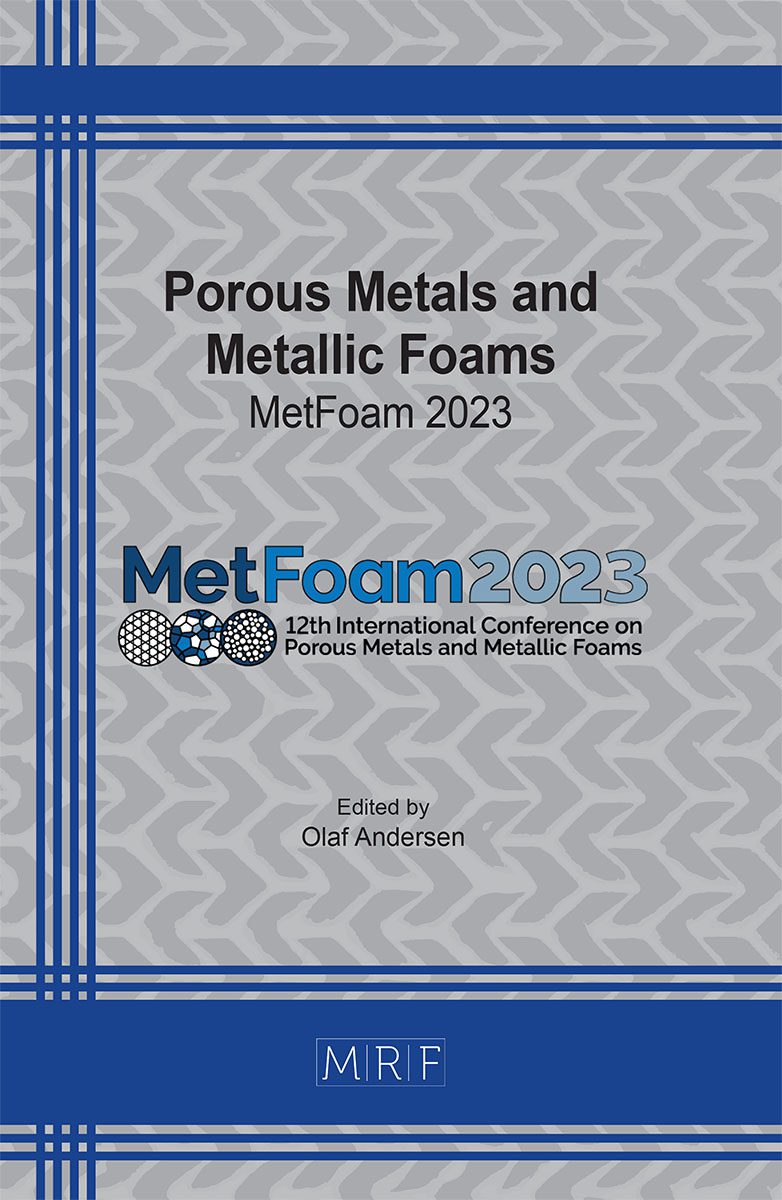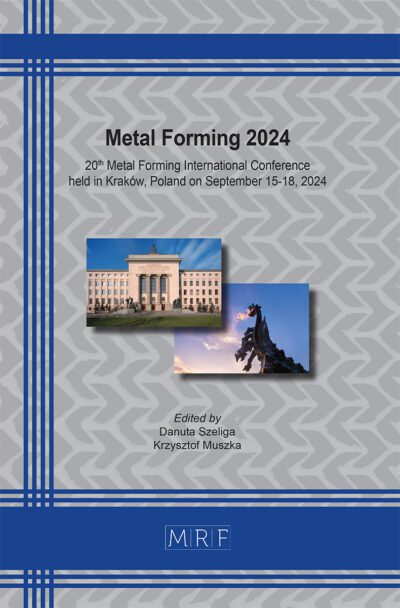Numerical Investigation on Deformation Behavior of Aluminium Foams with in situ Composite Particles
M. Rakesh, A. Tewari, S. Karagadde
download PDFAbstract. Metal foams are cellular solids with high stiffness, high strength and superior energy absorption capacity. In liquid metallurgy, foams are processed by foaming the molten metal with the addition of foaming agents and stabilized by the presence of particles which also strengthen the cell walls. An analysis of the deformation behaviour of foams in the presence of these stabilizing particles is essential to the mechanism of energy absorption. In the present study, the effect of the particle distribution on the deformation behaviour of the closed-cell aluminium foams was investigated using Finite Element Analysis (FEA) in Abaqus© software. The experimental data were used to model the distribution of particles in the matrix and the foam model. The simulation results were validated with the experimental results. The uniform distribution of particles in the matrix resulted in lower stress concentration and enhanced the mechanical performance of composite material and the metal foam.
Keywords
Metal Matrix Composite, in situ Metal Foam, Finite Element Analysis, Liquid Metallurgy Process, Energy Absorption
Published online 2/25/2024, 9 pages
Copyright © 2024 by the author(s)
Published under license by Materials Research Forum LLC., Millersville PA, USA
Citation: M. Rakesh, A. Tewari, S. Karagadde, Numerical Investigation on Deformation Behavior of Aluminium Foams with in situ Composite Particles, Materials Research Proceedings, Vol. 39, pp 42-50, 2024
DOI: https://doi.org/10.21741/9781644903094-6
The article was published as article 6 of the book Porous Metals and Metallic Foams
![]() Content from this work may be used under the terms of the Creative Commons Attribution 3.0 license. Any further distribution of this work must maintain attribution to the author(s) and the title of the work, journal citation and DOI.
Content from this work may be used under the terms of the Creative Commons Attribution 3.0 license. Any further distribution of this work must maintain attribution to the author(s) and the title of the work, journal citation and DOI.
References
[1] Gibson, L.J., Ashby, M.F.: Cellular Solids. Cell. Solids. (1997). https://doi.org/10.1017/cbo9781139878326
[2] Banhart, J.: Manufacture, characterisation and application of cellular metals and metal foams. Prog. Mater. Sci. 46, 559–632 (2001). https://doi.org/10.1016/S0079-6425(00)00002-5
[3] Banhart, J.: Aluminium foams for lighter vehicles. Int. J. Veh. Des. 37, 114–125 (2005). https://doi.org/10.1504/IJVD.2005.006640
[4] Banhart, J.: Metal foams: Production and stability. Adv. Eng. Mater. 8, 781–794 (2006). https://doi.org/10.1002/adem.200600071
[5] Simone, A.E., Gibson, L.J.: Aluminum foams produced by liquid-state processes. Acta Mater. 46, 3109–3123 (1998). https://doi.org/10.1016/S1359-6454(98)00017-2
[6] Li, D.W., Li, J., Li, T., Sun, T., Zhang, X.M., Yao, G.C.: Preparation and characterization of aluminum foams with ZrH2 as foaming agent. Trans. Nonferrous Met. Soc. China (English Ed. 21, 346–352 (2011). https://doi.org/10.1016/S1003-6326(11)60720-6
[7] Rakesh, M., Srivastava, N., Bhagavath, S., Karagadde, S.: Role of In Situ Formed (Al3Zr + Al3Ti) Particles on Nucleation of Primary Phase in Al-5 wt.% Cu Alloy. J. Mater. Eng. Perform. 2, (2023). https://doi.org/10.1007/s11665-023-08417-z
[8] Atturan, U.A., Nandam, S.H., Murty, B.S., Sankaran, S.: Processing and characterization of in-situ TiB2 stabilized closed cell aluminium alloy composite foams. Mater. Des. 101, 245–253 (2016). https://doi.org/10.1016/j.matdes.2016.03.153
[9] Chawla, N., Sidhu, R.S., Ganesh, V. V.: Three-dimensional visualization and microstructure-based modeling of deformation in particle-reinforced composites. Acta Mater. 54, 1541–1548 (2006). https://doi.org/10.1016/j.actamat.2005.11.027
[10] Ma, S., Wang, X.: Mechanical properties and fracture of in-situ Al3Ti particulate reinforced A356 composites. Mater. Sci. Eng. A. 754, 46–56 (2019). https://doi.org/10.1016/j.msea.2019.03.044
[11] Ma, S., Zhang, X., Chen, T., Wang, X.: Microstructure-based numerical simulation of the mechanical properties and fracture of a Ti-Al3Ti core-shell structured particulate reinforced A356 composite. Mater. Des. 191, 108685 (2020). https://doi.org/10.1016/j.matdes.2020.108685
[12] Antunes, F. V., Ferreira, J.A.M., Capela, C.: Numerical modelling of the Young’s modulus of syntactic foams. Finite Elem. Anal. Des. 47, 78–84 (2011). https://doi.org/10.1016/j.finel.2010.09.007
[13] Nammi, S.K., Myler, P., Edwards, G.: Finite element analysis of closed-cell aluminium foam under quasi-static loading. Mater. Des. 31, 712–722 (2010). https://doi.org/10.1016/j.matdes.2009.08.010
[14] Pérez, L., Mercado, R., Alfonso, I.: Young’s modulus estimation for CNT reinforced metallic foams obtained using different space holder particles. Compos. Struct. 168, 26–32 (2017). https://doi.org/10.1016/j.compstruct.2017.02.017
[15] Shen, H., Brinson, L.C.: Finite element modeling of porous titanium. Int. J. Solids Struct. 44, 320–335 (2007). https://doi.org/10.1016/j.ijsolstr.2006.04.020
[16] Srivastava, N., Bhagavath, S., Karagadde, S.: Effect of in situ Al3Zr particles on controlling the pore morphology of Al6061 alloy foams. Mater. Today Commun. 26, 101853 (2021). https://doi.org/10.1016/j.mtcomm.2020.101853
[17] An, X., Liu, Y., Ye, J., Li, X.: Fabrication of in-situ TiC–TiB2 reinforced Al foam with enhanced properties, (2020)
[18] Yang, X., Yang, K., Wang, J., Shi, C., He, C., Li, J., Zhao, N.: Compressive Response and Energy Absorption Characteristics of In Situ Grown CNT-Reinforced Al Composite Foams. Adv. Eng. Mater. 19, 294–302 (2017). https://doi.org/10.1002/adem.201700431
[19] Ma, S., Zhuang, X., Wang, X.: Particle distribution-dependent micromechanical simulation on mechanical properties and damage behaviors of particle reinforced metal matrix composites. J. Mater. Sci. 56, 6780–6798 (2021). https://doi.org/10.1007/s10853-020-05684-2
[20] Pandee, P., Sankanit, P., Uthaisangsuk, V.: Structure-mechanical property relationships of in-situ A356/Al3Zr composites. Mater. Sci. Eng. A. 866, (2023). https://doi.org/10.1016/j.msea.2023.144673
[21] Dao, M., Chollacoop, N., Van Vliet, K.J., Venkatesh, T.A., Suresh, S.: COMPUTATIONAL MODELING OF THE FORWARD AND REVERSE PROBLEMS IN INSTRUMENTED SHARP INDENTATION. (2001)
[22] Okereke, M.I., Akpoyomare, A.I.: A virtual framework for prediction of full-field elastic response of unidirectional composites. Comput. Mater. Sci. 70, 82–99 (2013). https://doi.org/10.1016/j.commatsci.2012.12.036
[23] Akpoyomare, A.I., Okereke, M.I., Bingley, M.S.: Virtual testing of composites: Imposing periodic boundary conditions on general finite element meshes. Compos. Struct. 160, 983–994 (2017). https://doi.org/10.1016/j.compstruct.2016.10.114
[24] Zhou, J., Gokhale, A.M., Gurumurthy, A., Bhat, S.P.: Realistic microstructural RVE-based simulations of stress-strain behavior of a dual-phase steel having high martensite volume fraction. Mater. Sci. Eng. A. 630, 107–115 (2015). https://doi.org/10.1016/j.msea.2015.02.017
[25] Yang, X., Hu, Q., Du, J., Song, H., Zou, T., Sha, J., He, C., Zhao, N.: Compression fatigue properties of open-cell aluminum foams fabricated by space-holder method. Int. J. Fatigue. 121, 272–280 (2019). https://doi.org/10.1016/j.ijfatigue.2018.11.008
[26] Bensalem, I., Benhizia, A.: Novel design of irregular closed-cell foams structures based on spherical particle inflation and evaluation of its compressive performance. Thin-Walled Struct. 181, (2022). https://doi.org/10.1016/j.tws.2022.109991
[27] Abstract of : ISO 13314 : 2011 Mechanical testing of metals — Ductility testing — Compression test for porous and cellular metals Foreword 1 Scope 2 Normative references 3 Terms and definitions. 1–3














